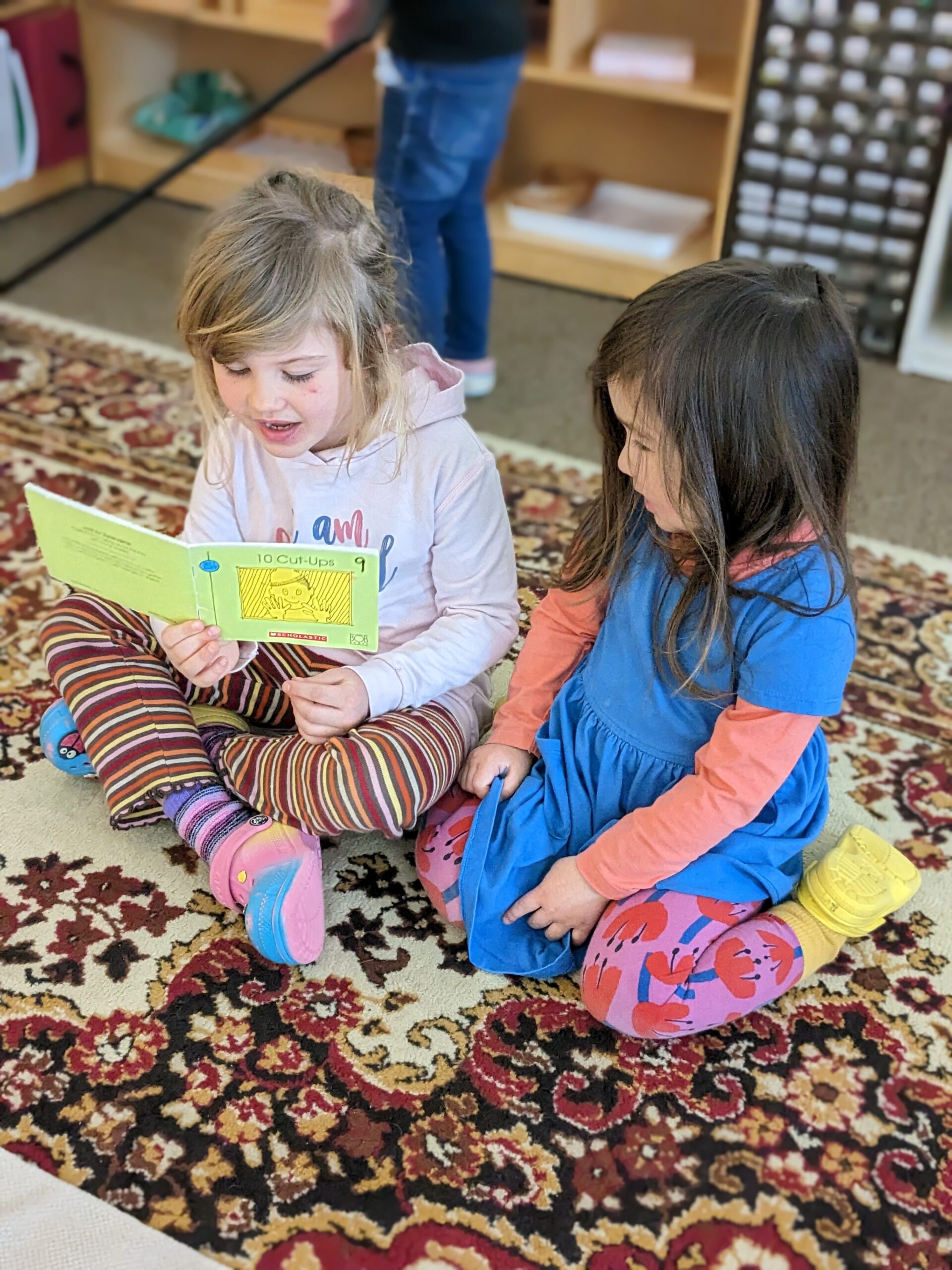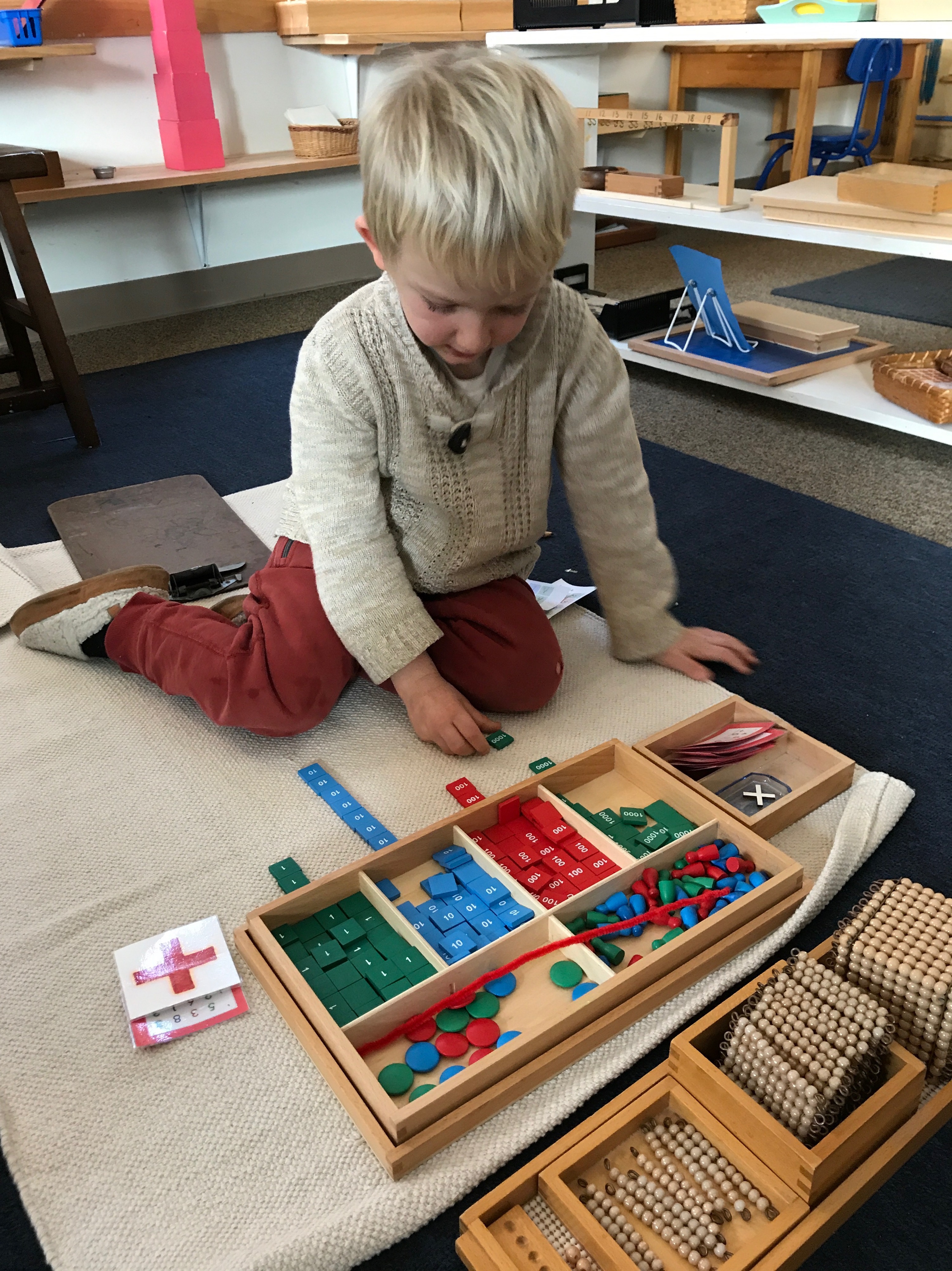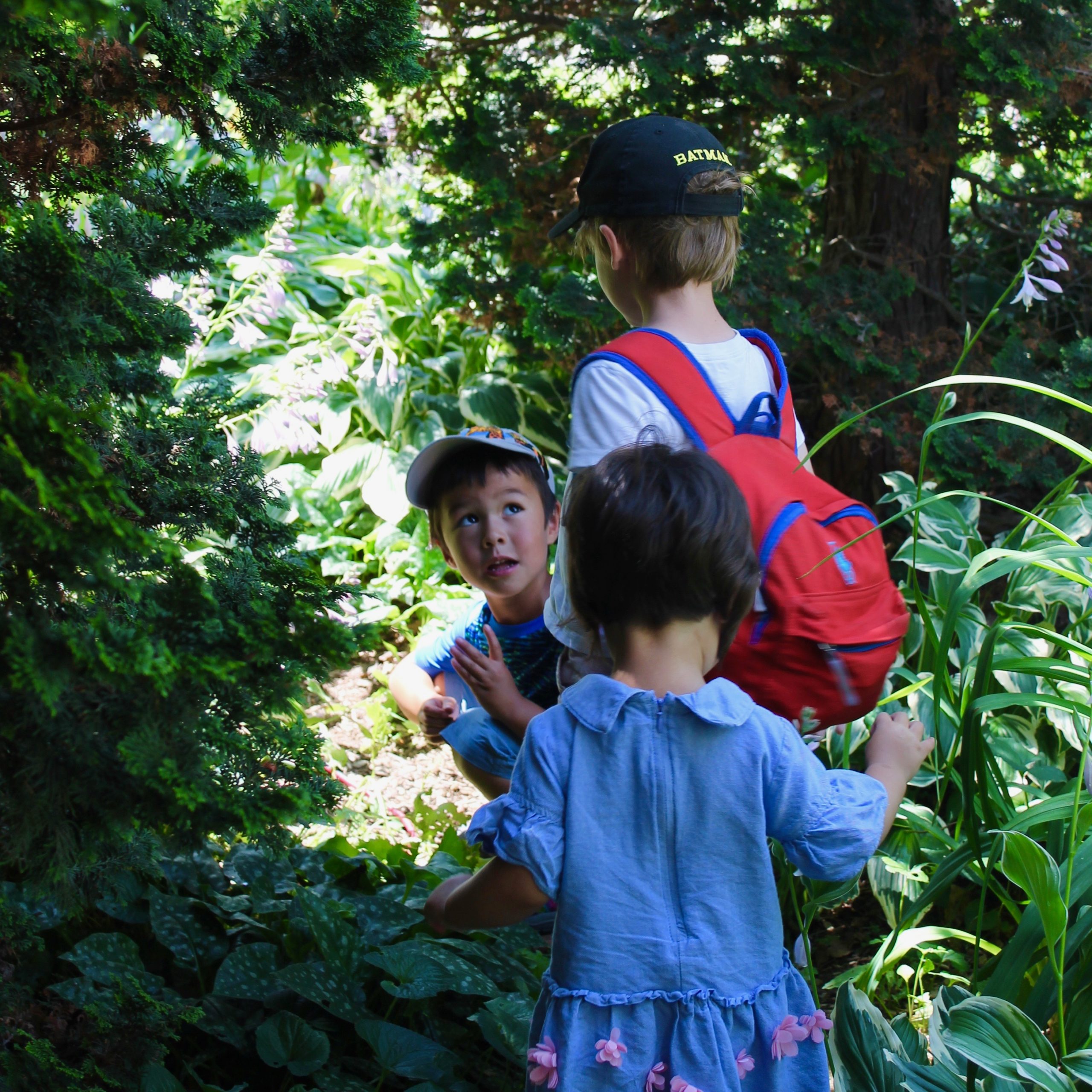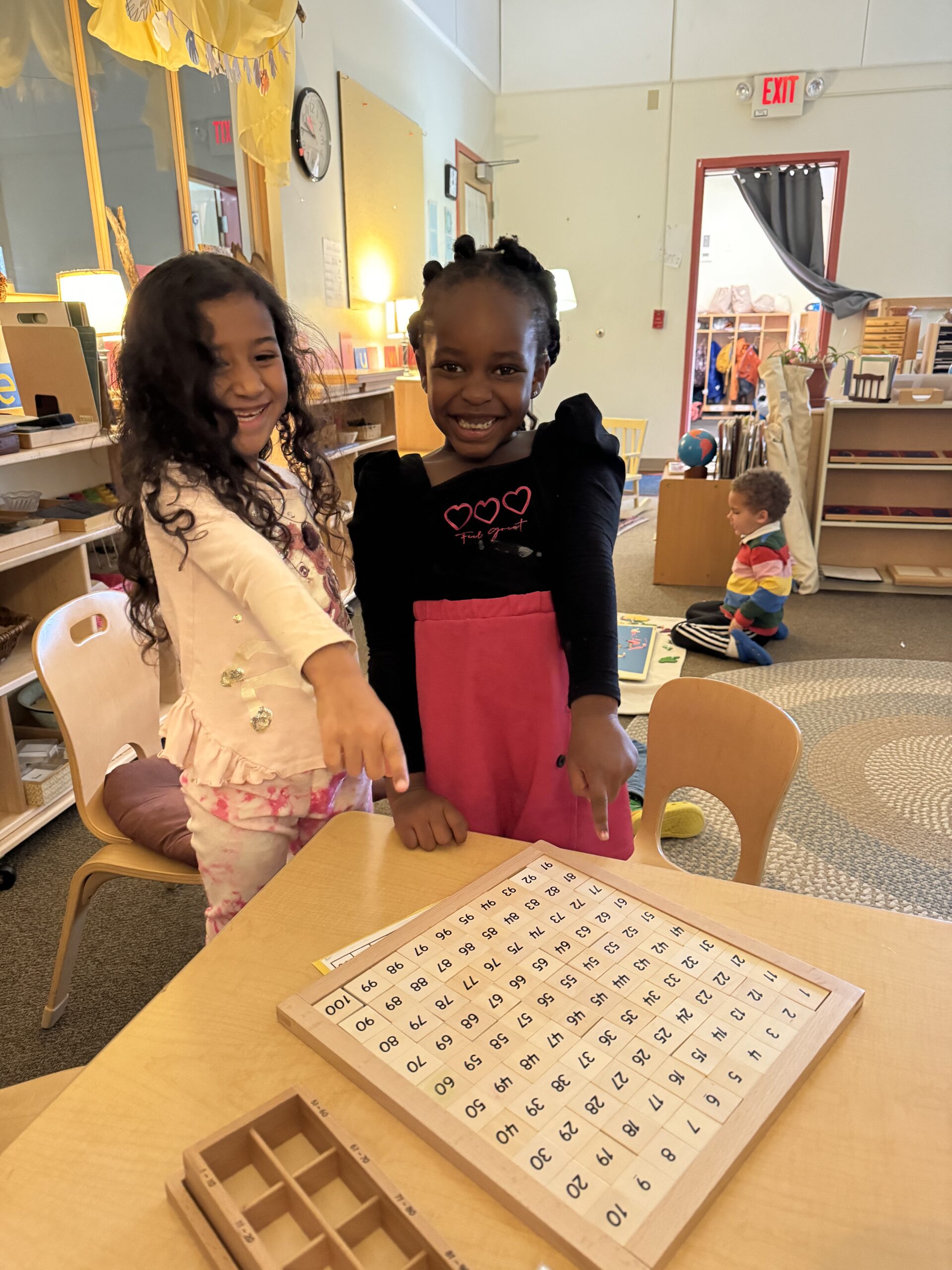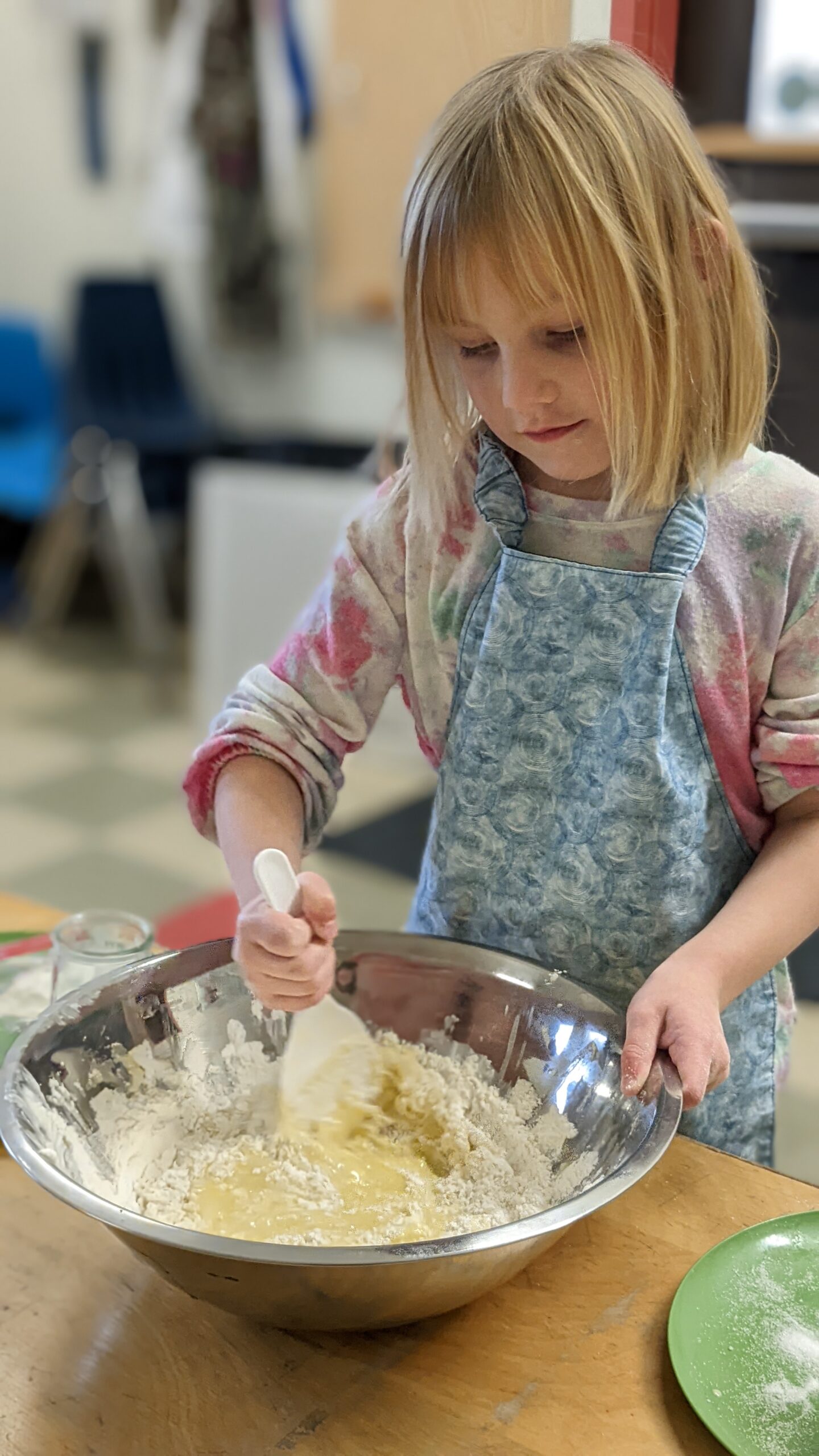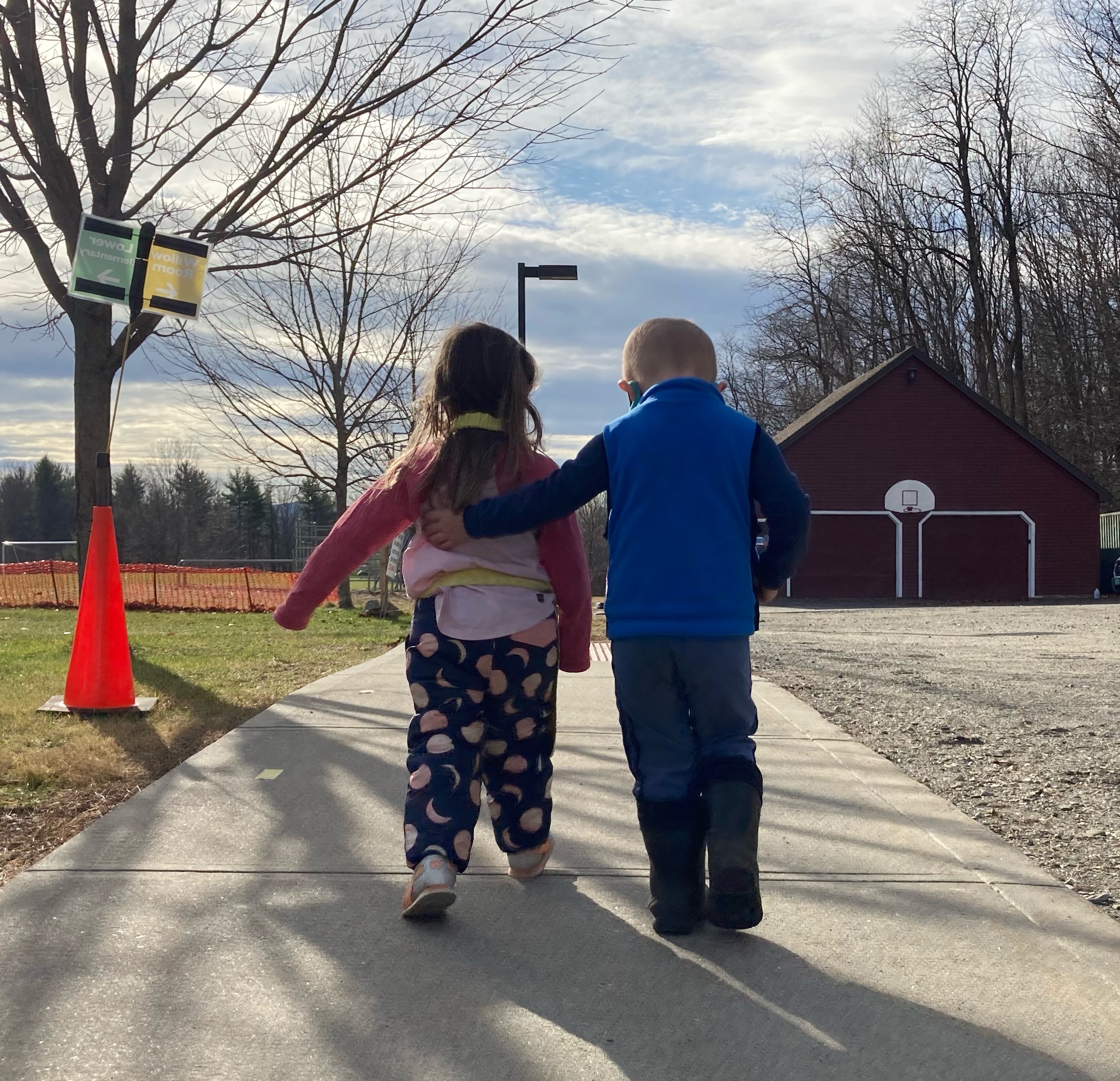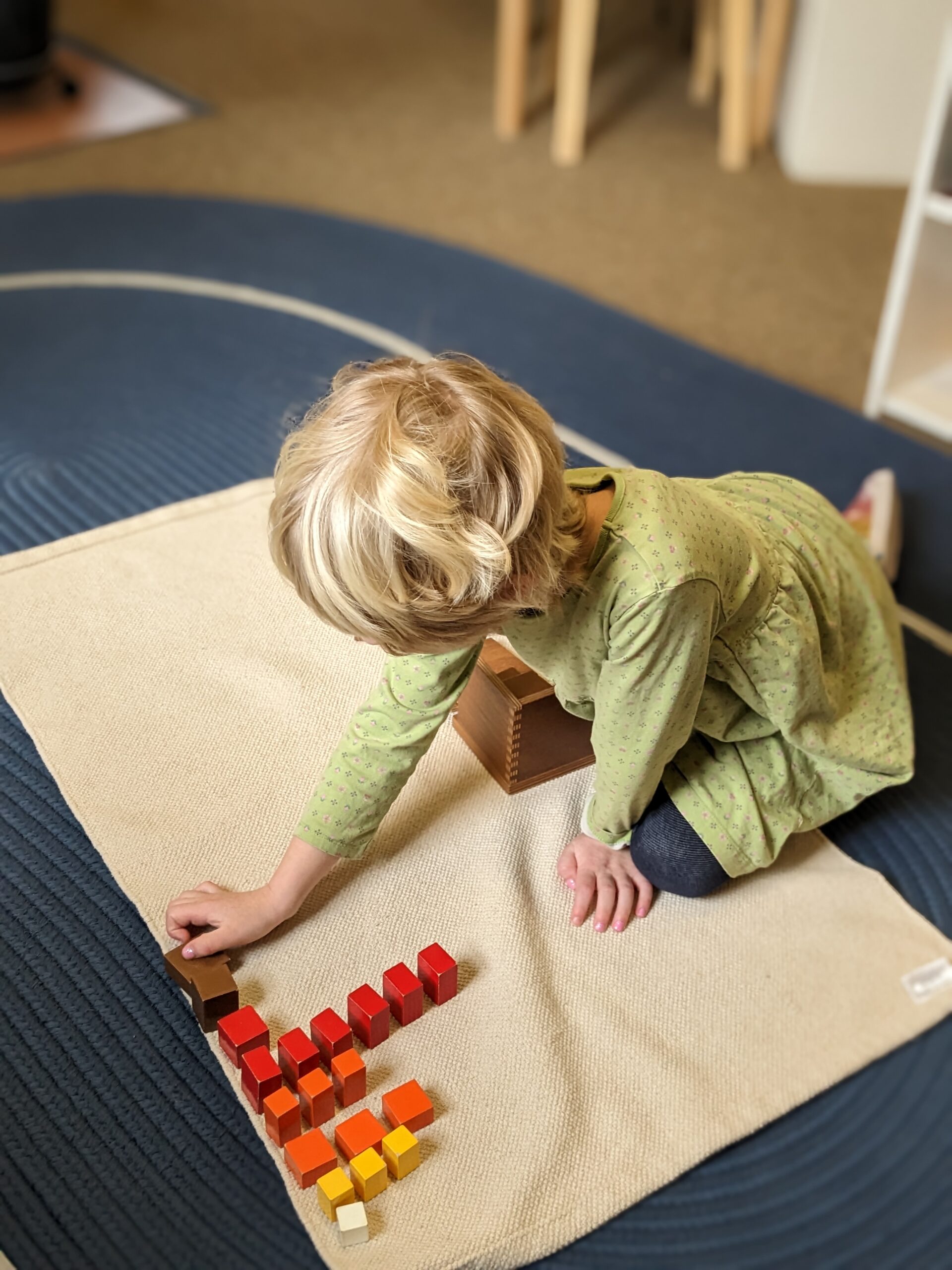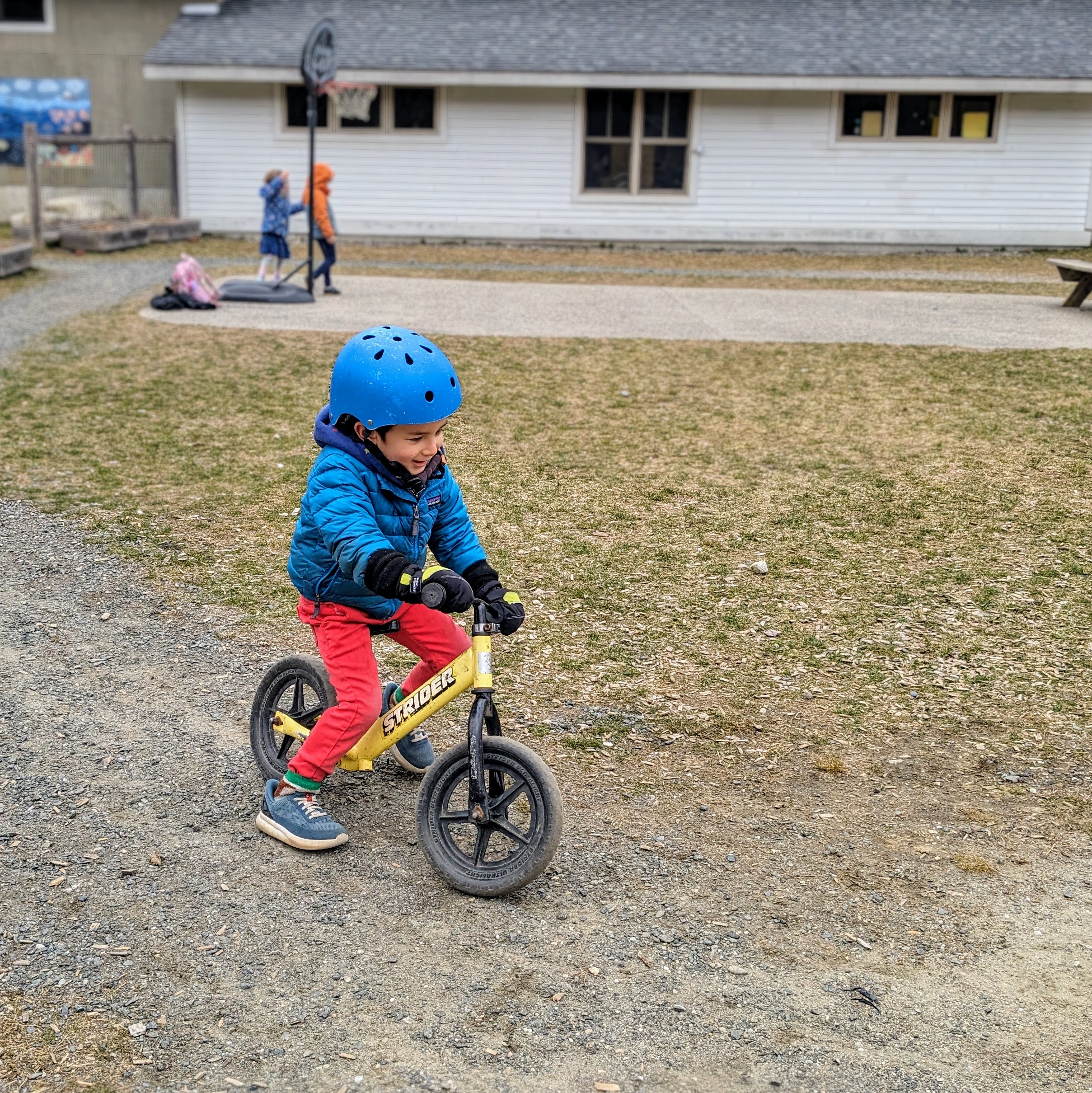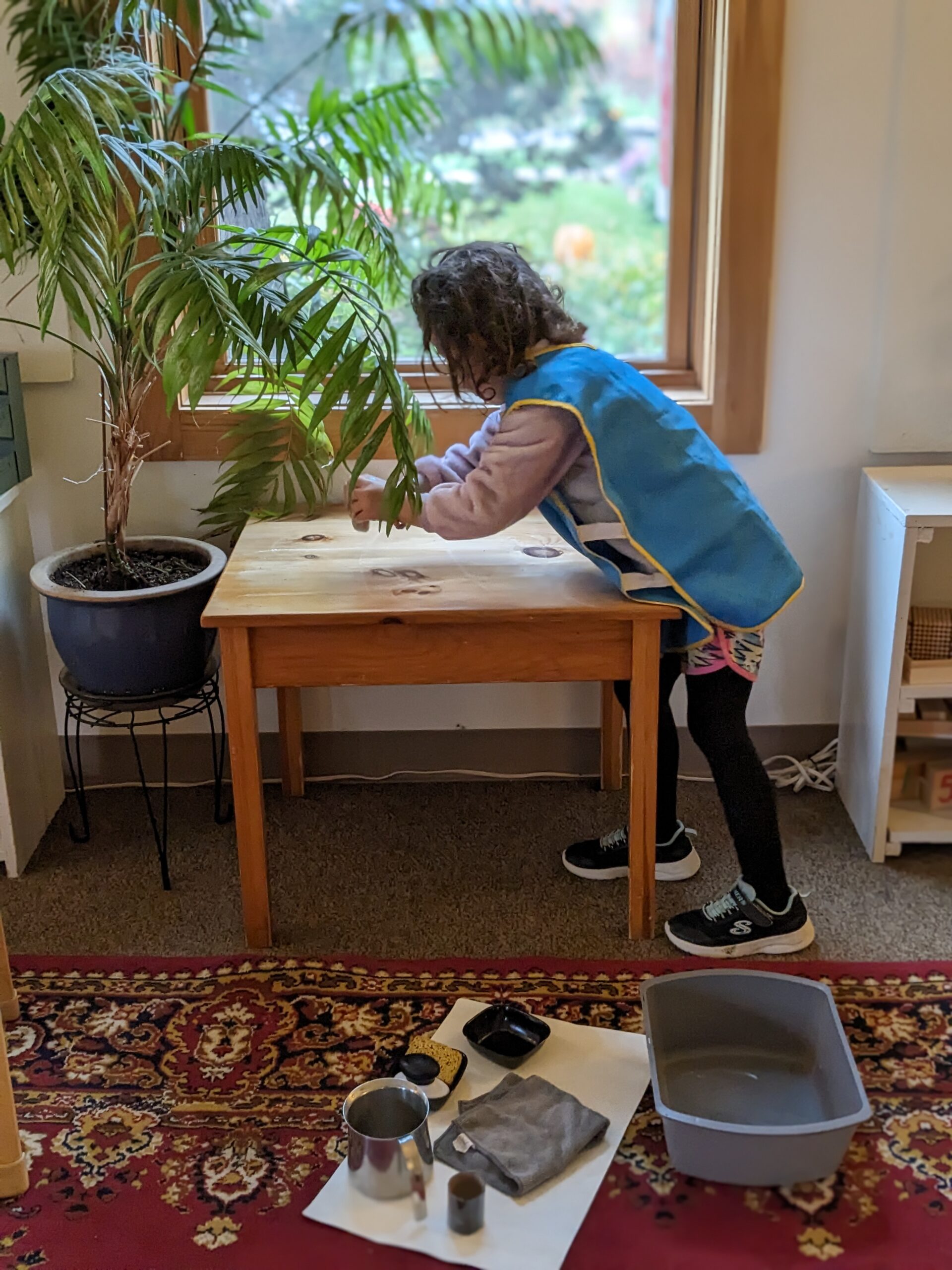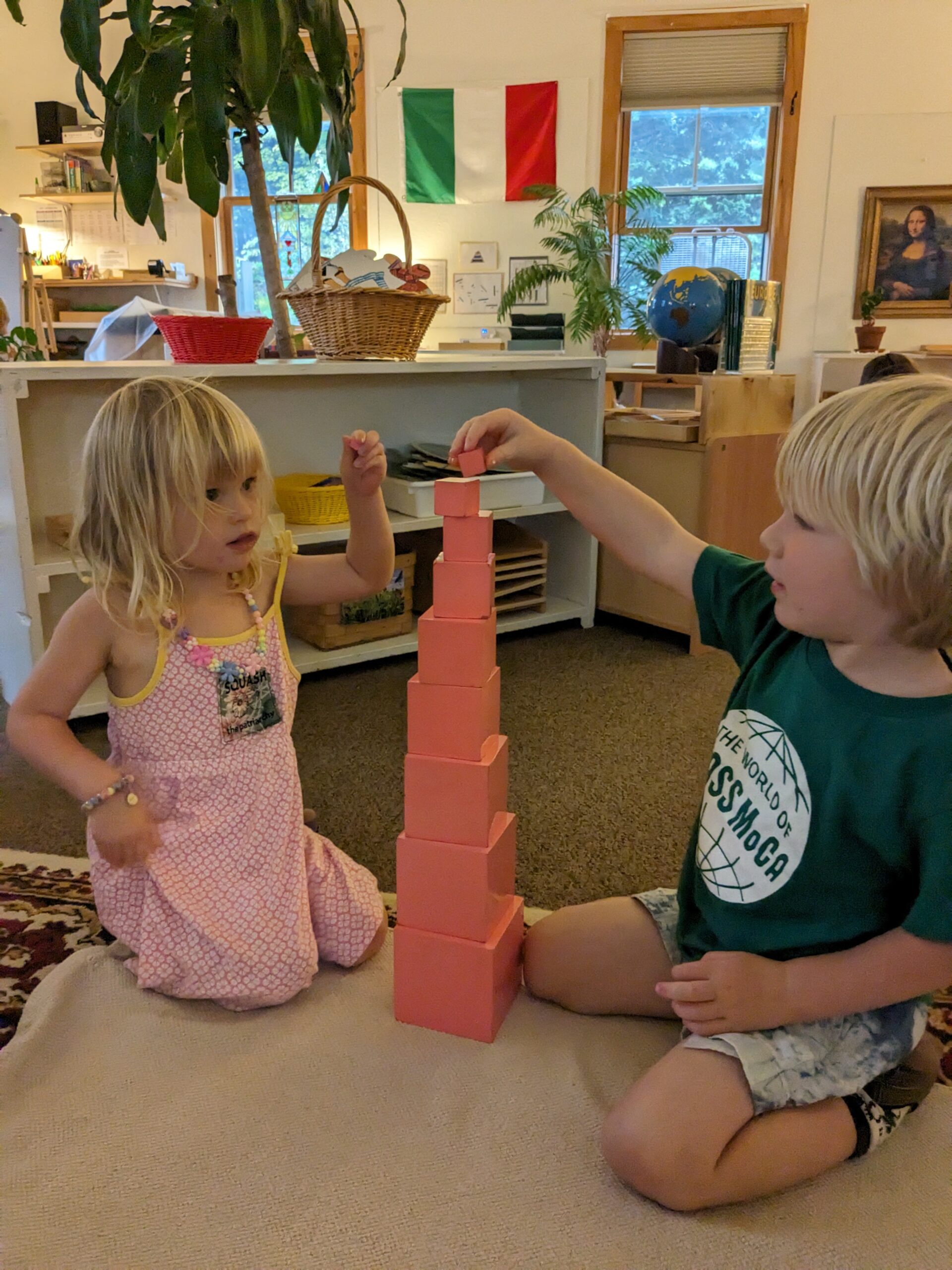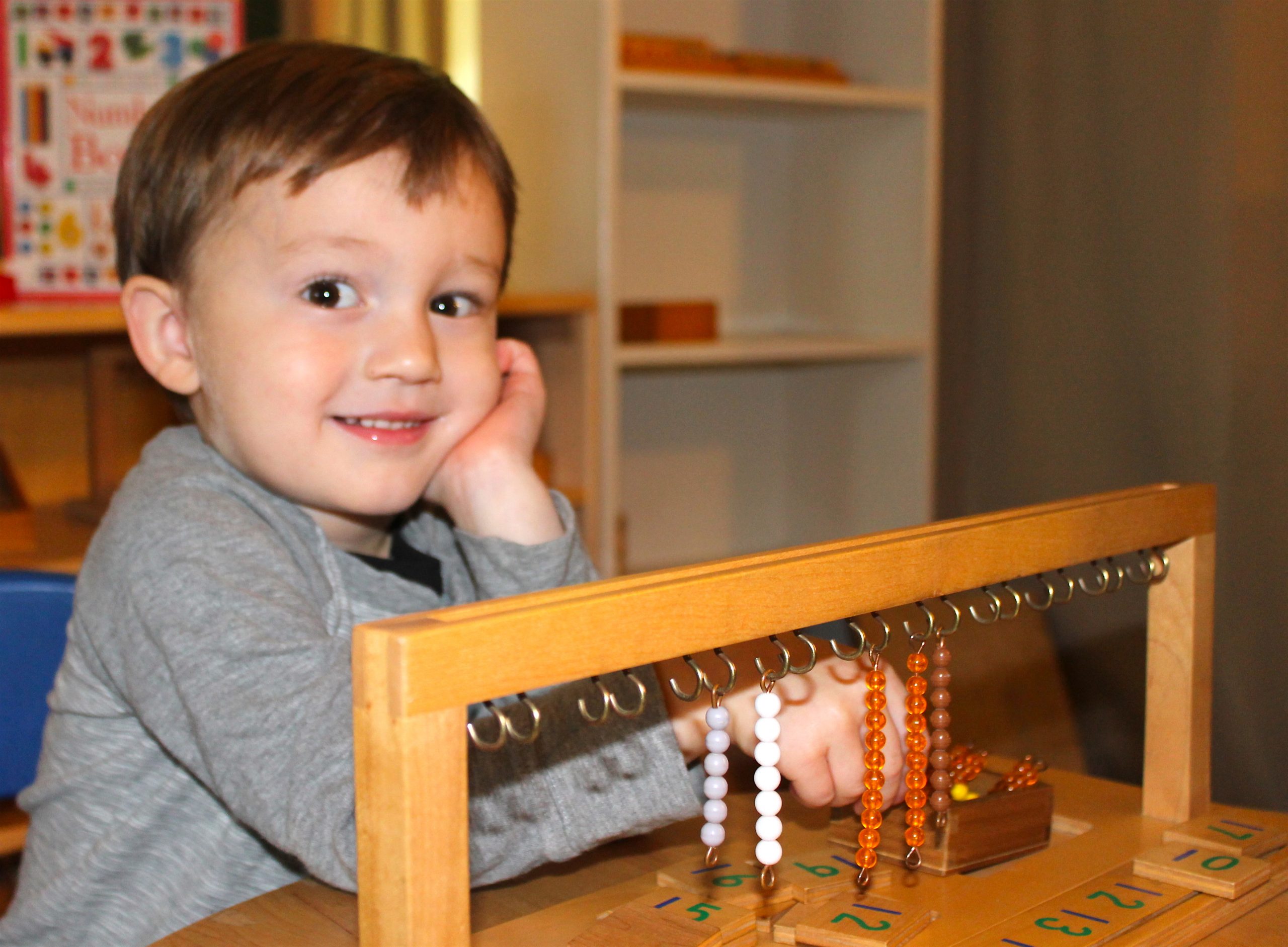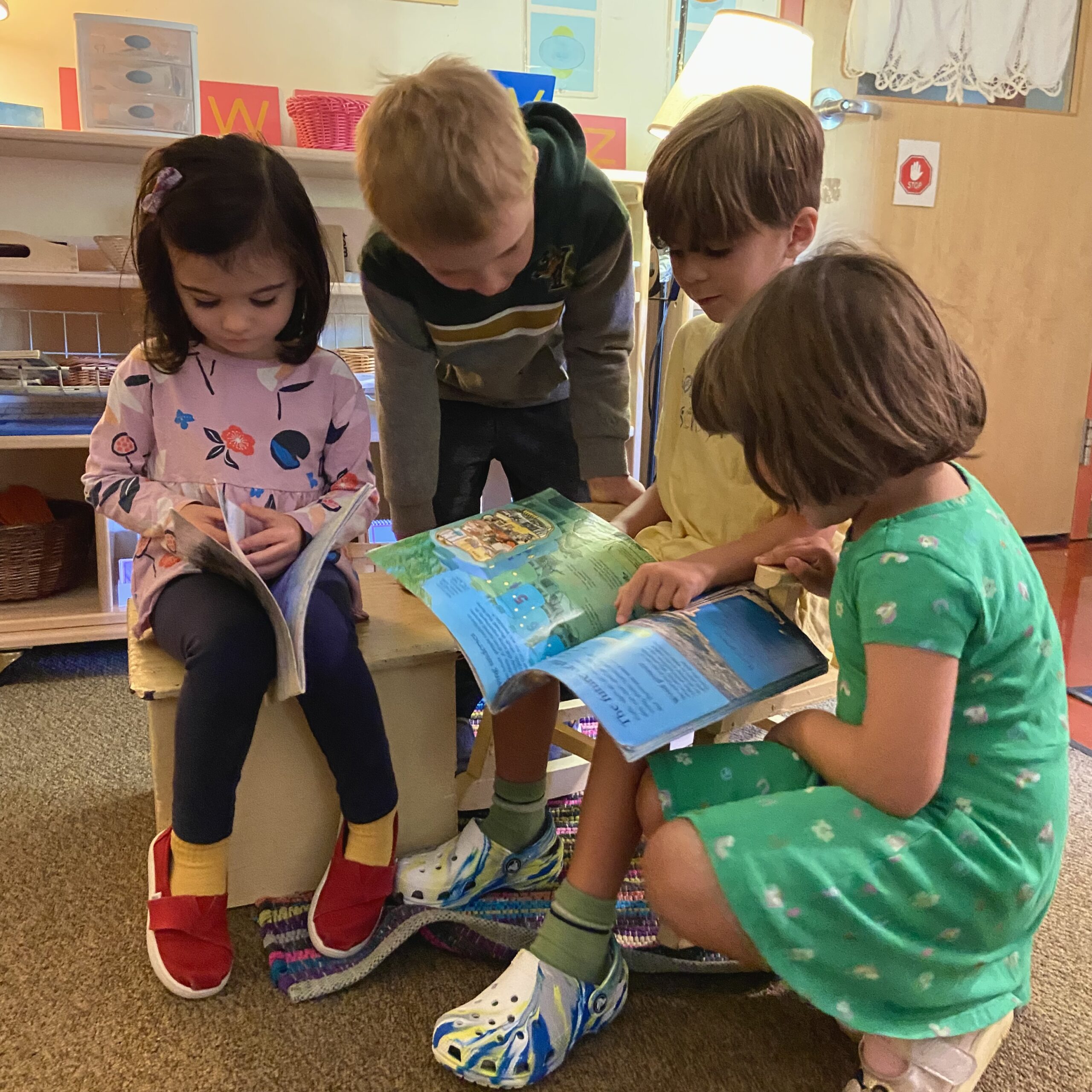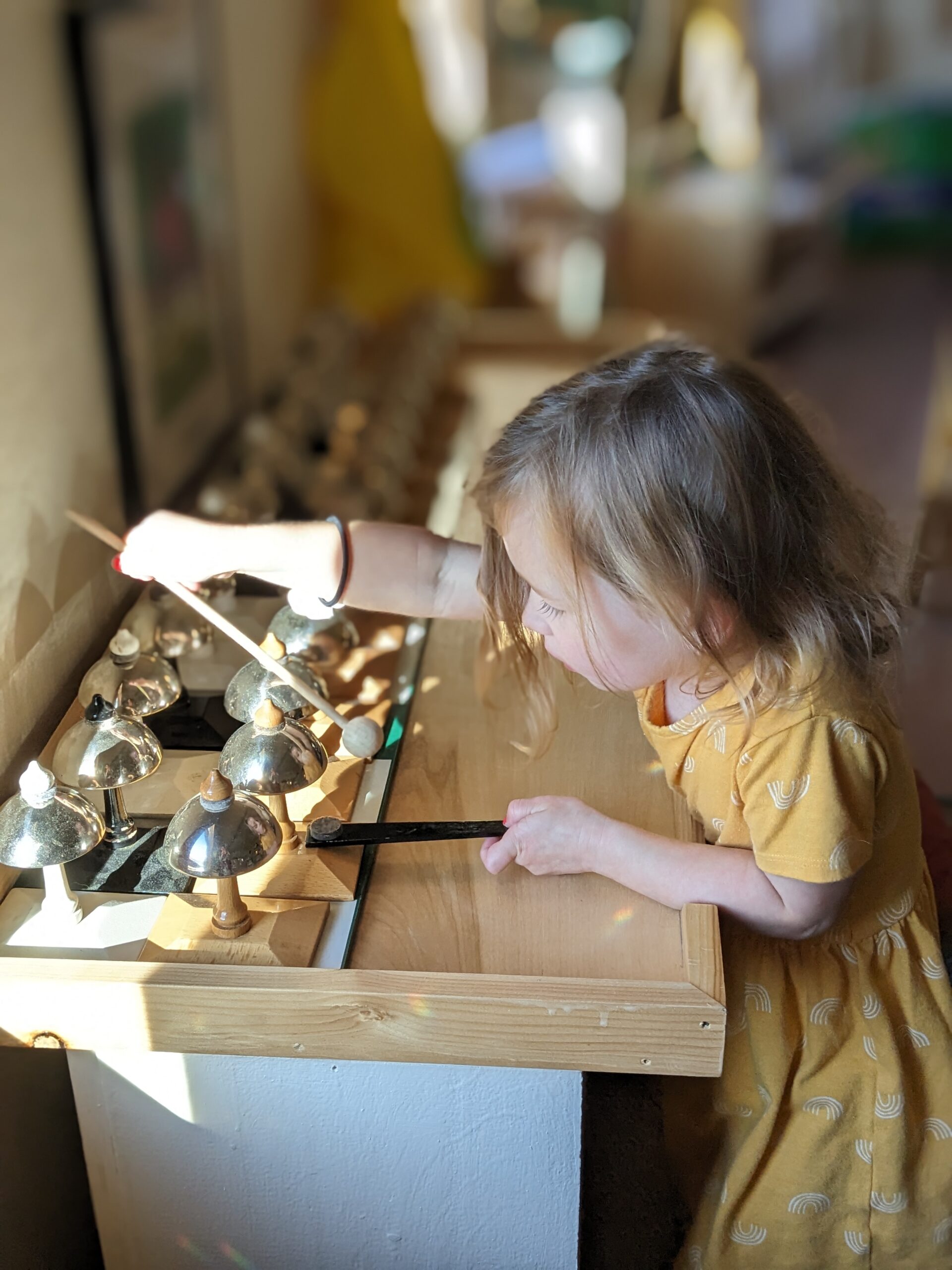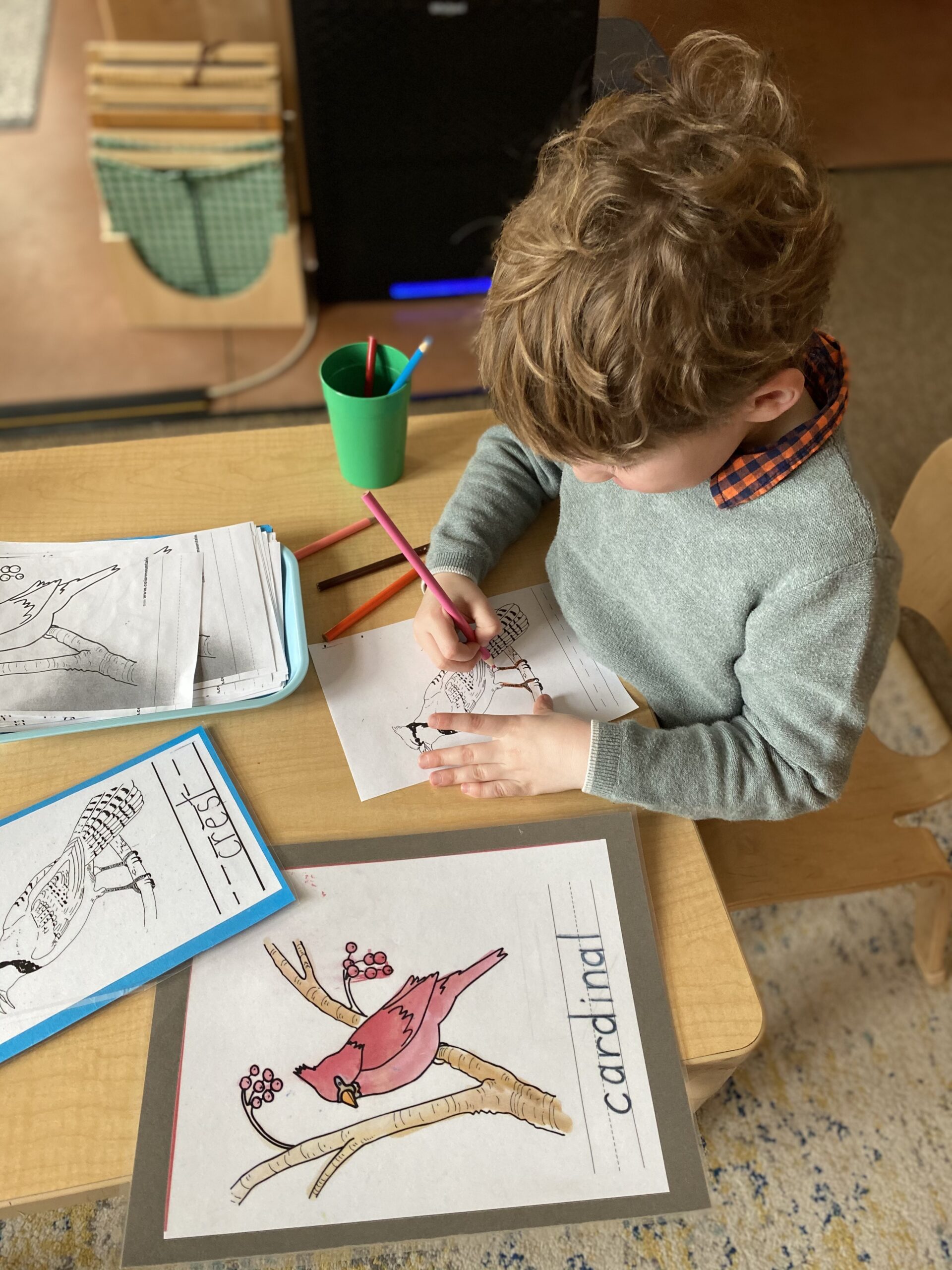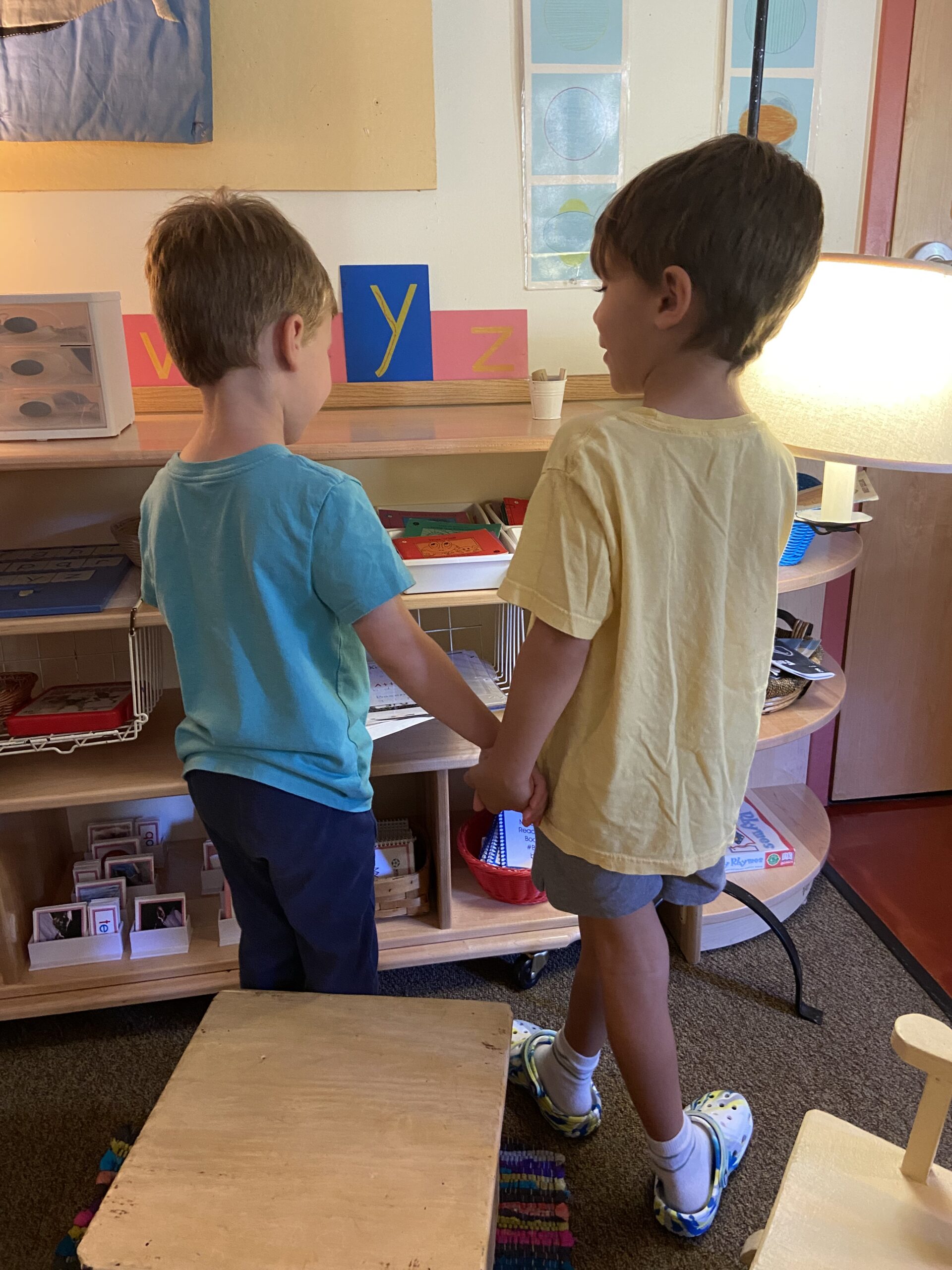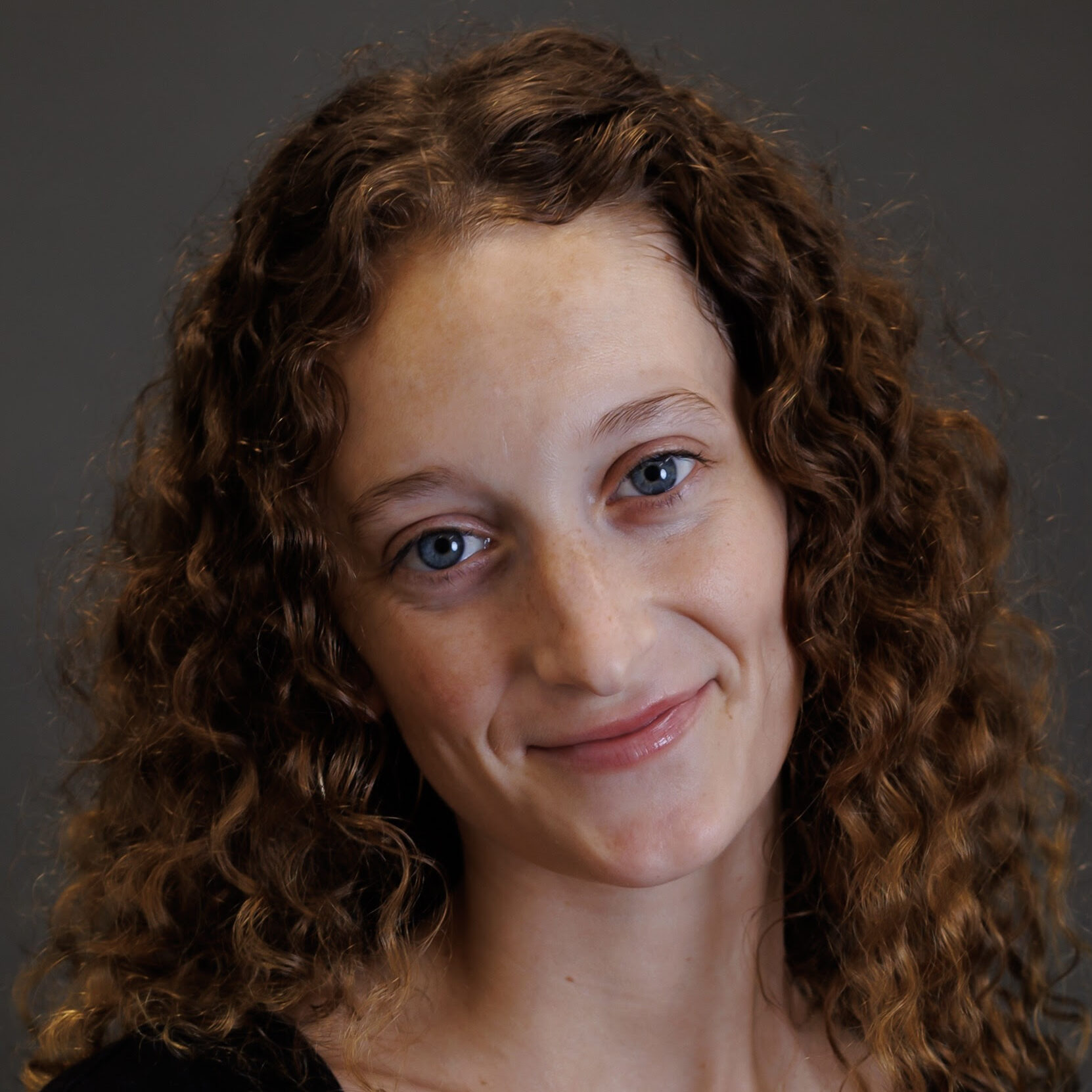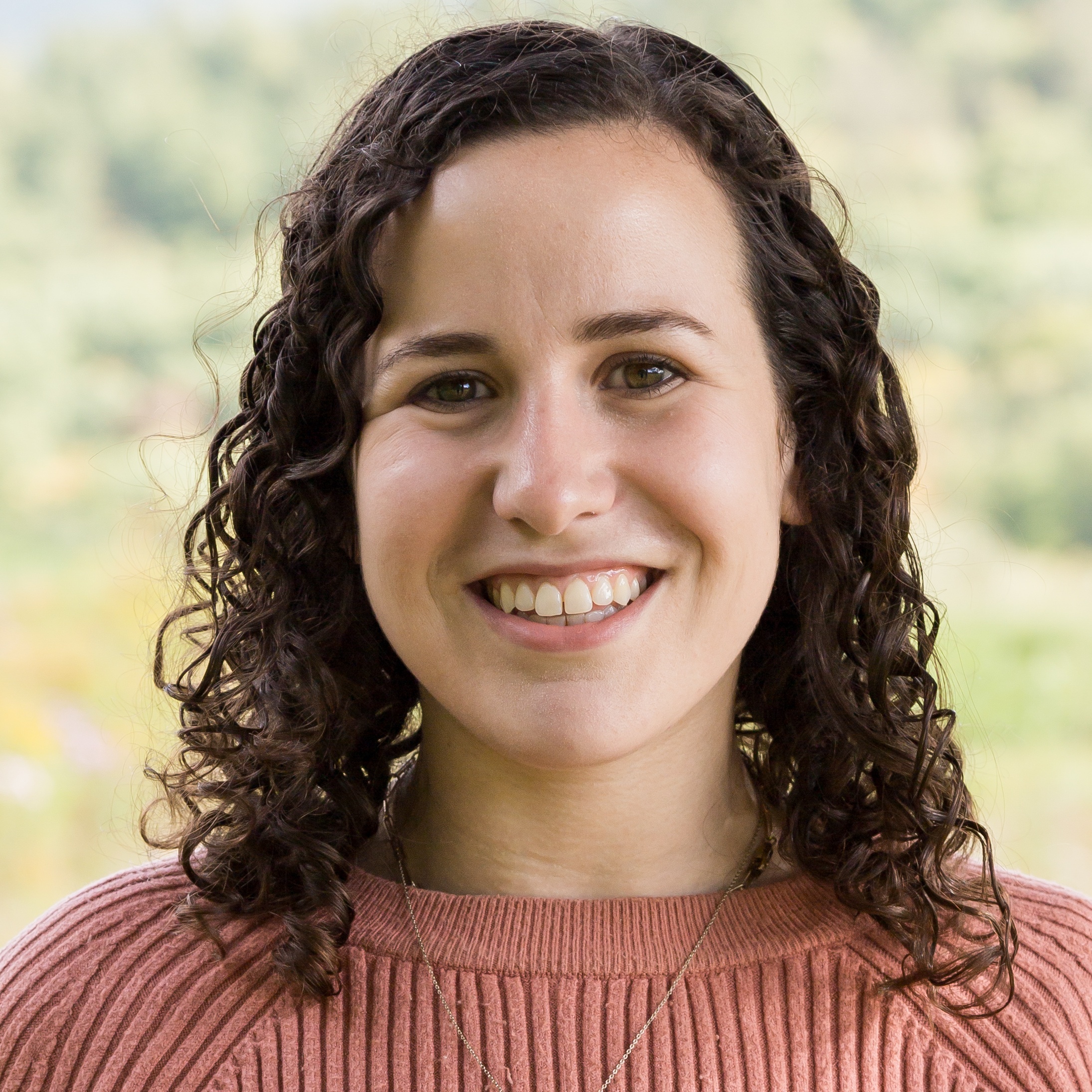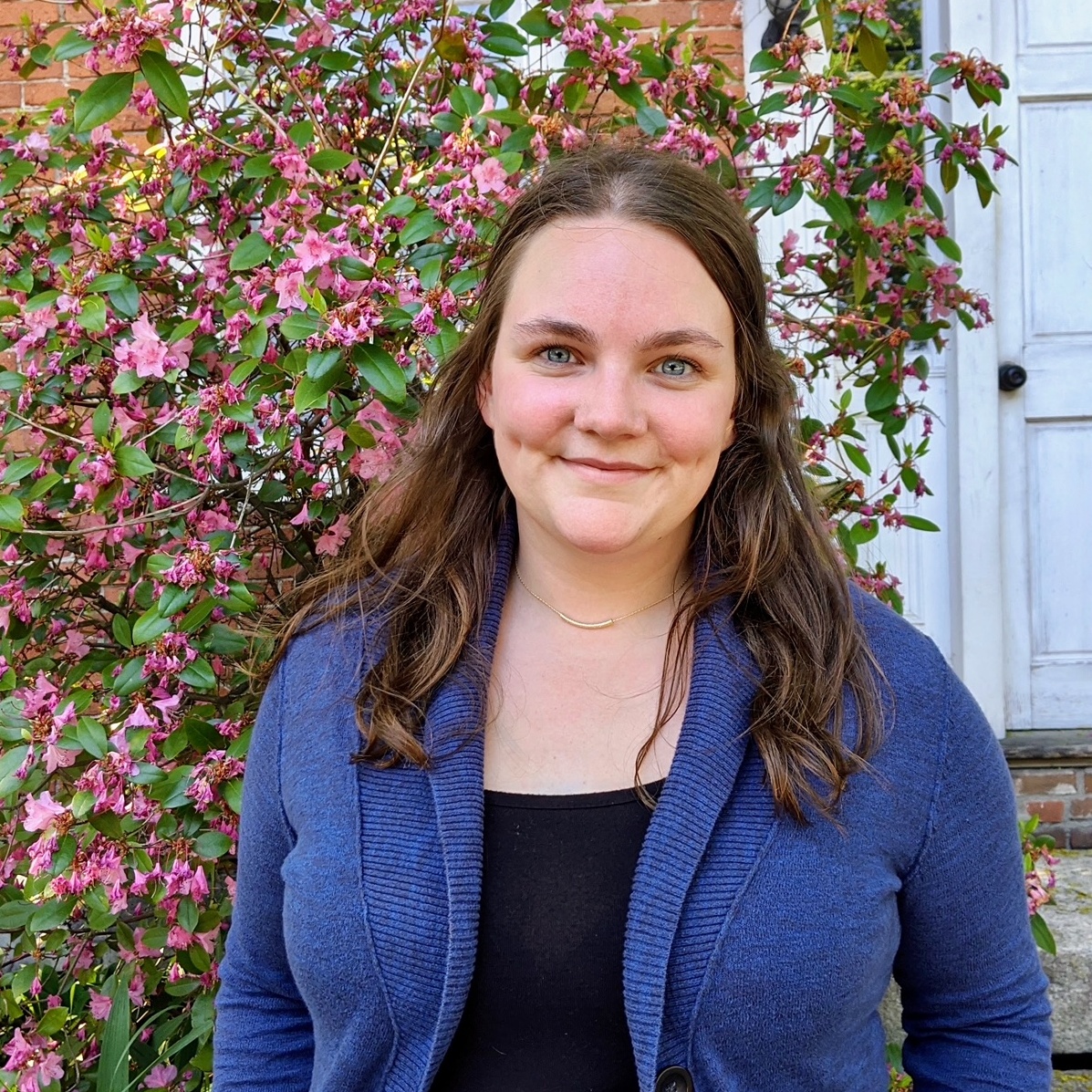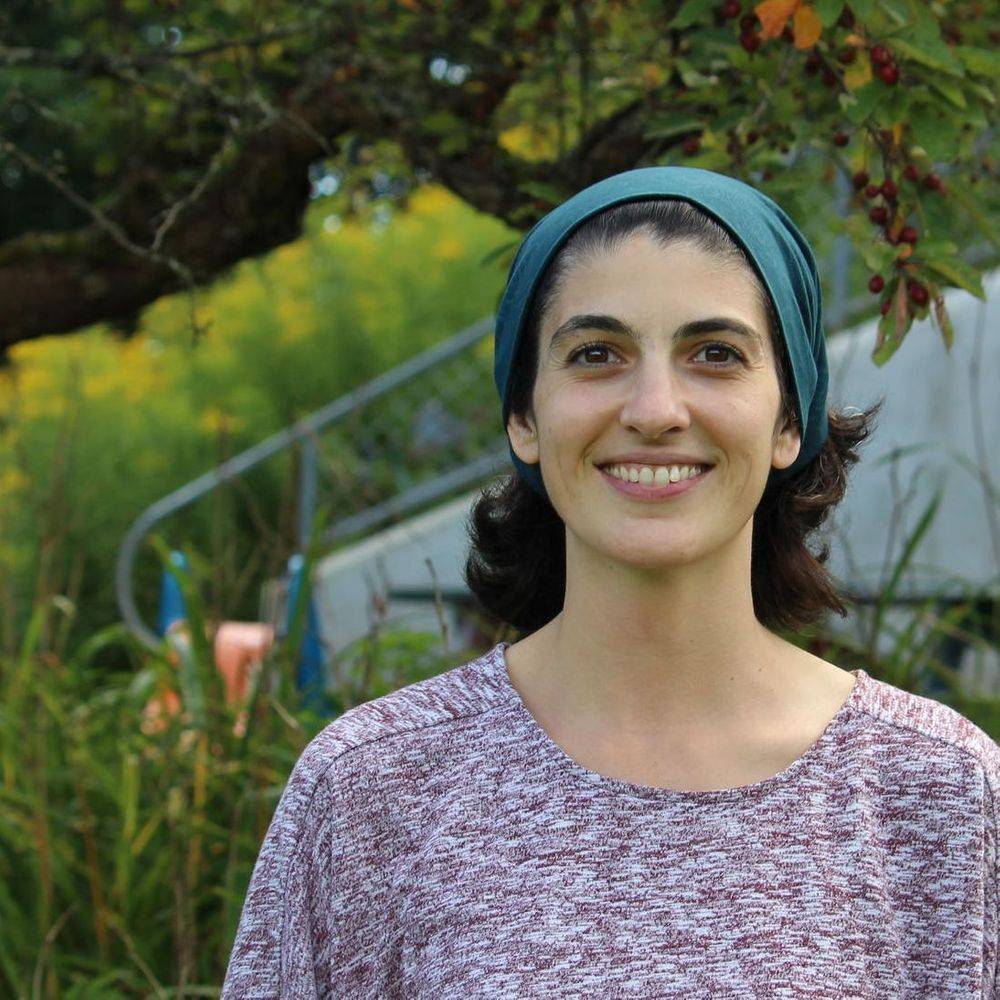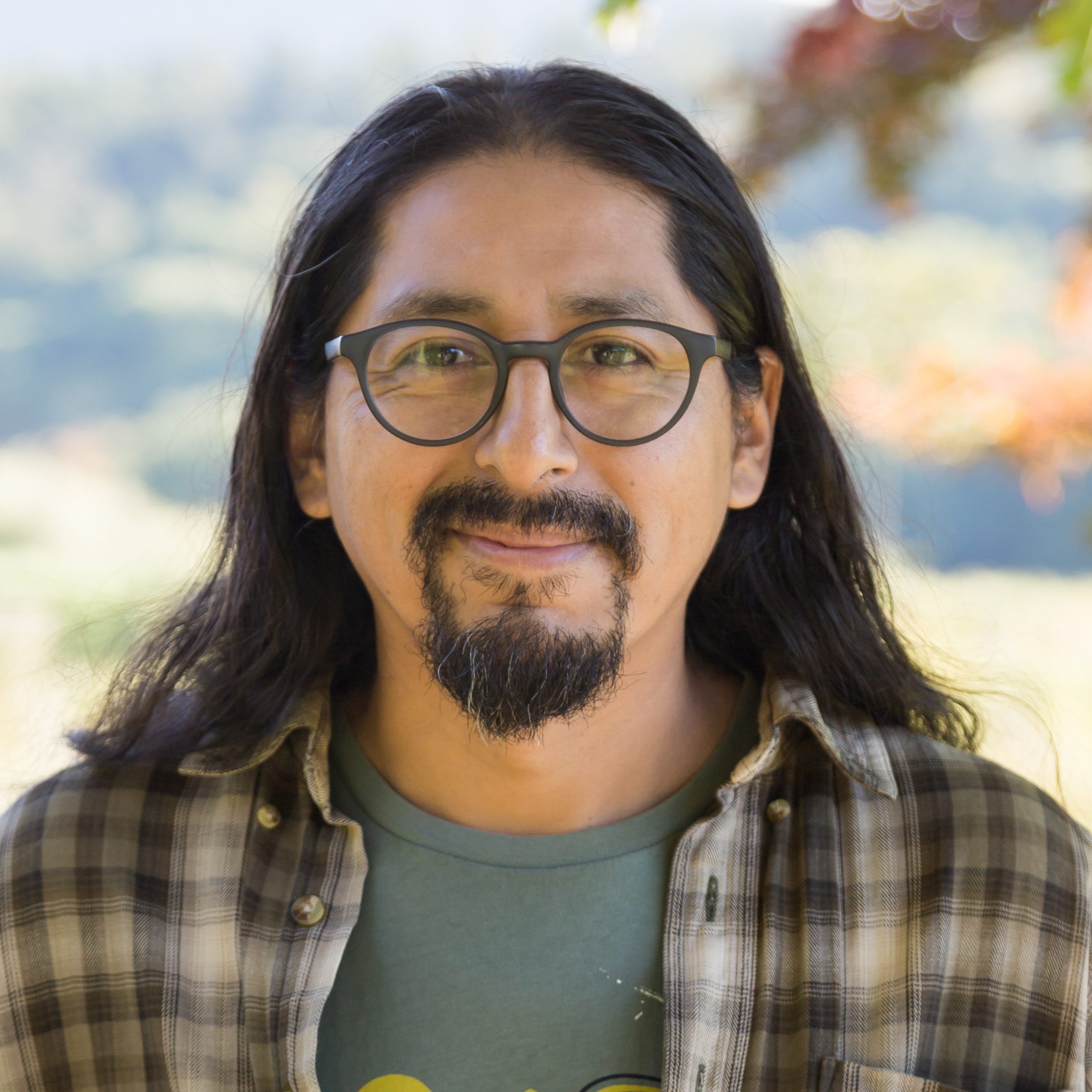Children’s House
Ages 3 to 6 // Pre-K and Kindergarten
The Children’s House classrooms, including Pre-K and Kindergarten children in the same multi-age group, first and foremost, are a “children’s house”: a calming and respectful space that belongs to the children in scale, proportion, flow, comfort, safety, and inspiration. It is a hands-on, interactive, sensorial environment that “calls” to them. It is a place “of grace and beauty”. It is here that the seeds of literacy, numeracy, care of self, others and the environment are sown. Both the practical and wondrous are offered in response to the child’s innate striving toward independence, toward the desire and ability to “do it for myself”.
Curriculum
Integrated Curriculum and the Whole Child
At Hilltop we offer a full and rounded curriculum of topics and materials for our 3 to 6 year olds. These “subjects” are fully integrated, as one activity or “work” can cover a variety of areas. By doing this, we are also considering the development of the whole child. We aren’t focused only on typically academic topics but also on the social/emotional and artistic development and expression of every student.
Practical Life
A Quest for Coordination, Concentration, Independence, and Order
A child possesses the innate ability to absorb incredible amounts of information. This absorbent mind is a stage of development in which the child observes everything, absorbing it all equally, and then later assembling the absorbed impressions. The Practical Life area of a Montessori classroom is designed to provide experiences that enable the child to work to create themselves. These experiences, or exercises, contain the very essence of Dr. Montessori’s teachings. They guide the child’s efforts toward a central goal: the conquest of independence.
Practical Life attends to the development of a child’s physical skills, care of the person, care of the environment, and grace and courtesy. Each of these focal points provides for the development of order, concentration, coordination, and independent functioning, in turn, building self-confidence and a positive self-image. These Practical Life exercises are the backbone of the entire Montessori curriculum.
Language
Language development is one of the young child’s greatest works. The entirety of the Montessori curriculum, therefore, is designed and sequenced to engage children in activities that encourage and promote the growth of skills required for the acquisition of oral and written language. The child’s language development is respected and nourished through spontaneous conversation, group discussion, oral games, and listening games.
Oral Language is carefully nourished and guided in its expansion. Stories read on circle and listened to on tape provide rich literature experiences. The child engages in matching works: matching object to object, object to picture, and eventually three part matching. Sandpaper letter lessons and initial sound card games lead to work with the Movable Alphabet with which letters and letter sounds are identified, generated and eventually blended to form words. The desire to share these words with family and friends motivates the child to write these words to create a book. This in turn promotes an awareness of how both the written and spoken word carry a message: It is power to communicate.
Geography and Culture
Geography is the study of the Earth and its features and of the distribution of life thereon, including human life and the impact of human activity.
The Primary Geography curriculum includes the studies of air, land and water, land and water forms, continent globes and maps, mapping, flags, and time. When a child works with these materials and these important topics they learn to respect the world in which they are an intrinsic part. Most important, they learn that everyone and every country has something important and vital to offer and that they must take care of one another in order to live in peace and harmony.
Mathematics
Math is a never ending activity for the young, wondrous mind. There is always a next step to move toward. Dr. Montessori believed, “Wherever there is real education we will find that the children will be led to greater mathematical understanding and whenever there is mathematical understanding it will lead to much greater all round education and knowledge of the world!”
The direct aims of the Montessori math curriculum are to develop the mathematical mind through ordering and concentration. Students also learn coordination through precise placement of materials and independence by working alone and trusting oneself. Predictability, exactness, and understanding are learned through the consistent fixed quantities of the concrete materials. The child works with base ten, uses visual discrimination and association of size, color, and form, and thus learns to grade, sort, match, and recognize differences and similarities, and familiarity with quantities.
The child is prepared for the four operations of math—addition, subtraction, multiplication and division—through the pre-math areas of the classroom. Works designed to stimulate one to one correspondence, concrete positioning of objects, abstract place value of numbers, sorting, matching, eye and hand coordination and the relationship of a whole and its parts lay the foundations for future mathematical inquiry.
Science
Integrated into exploration of physical geography and culture, science is introduced through inquiry and concrete understanding of the natural world. We explore nomenclature and basic classification, such as “Living and Non-living,” “Sink and Float,” and “Vertebrate and Invertebrate,” and others. Identification, classification, and observation through basic experimentation allow a child to develop their own discoveries. As children get older, we elaborate on our knowledge to explore more abstract concepts.
Sensorial
The Sensorial area in the Montessori classroom is alive with materials that call out to the child: “Look at me.” “Touch me.” “Hold me.” “Listen to me.” These materials are designed for the development and refinement of the ability to observe, compare, discriminate, differentiate, reason, decide, and solve problems. The child is urged by what they see to explore the materials with their hands. A child engaged with the Sensorial works expresses joy and amazement as their hand is connected with the development of the mind.
The child who has been given the gift of sensori-motor learning—the opportunity to construct a visual image from the manipulation of a physical object—has been allowed to develop a secure foundation for their intellectual growth and activity.
Outdoor and Leadership Spanish-PE Program for Kindergarten Students
Our outdoor-based, multidisciplinary Spanish-PE program combines the teaching of Physical Education with a dynamic and holistic approach to language and culture exposure, while simultaneously being in motion, developing coordination and strength, and being surrounded by nature. This program is held twice weekly throughout the whole academic school year, focusing on exploration and personal growth while furthering the children’s responsible independence. Children carry their backpacks with gear, learn to cook over the fire, and hike paths that may challenge them.
The goal of Children’s House Spanish-PE program is for students to appreciate and value learning a new language and understand that there are diverse ways to communicate globally. We introduce children to the experience of listening, pronouncing, and appreciating Spanish through songs, storytelling, games, artifact-making, cooking, and small hikes. Through these activities, students become familiarized and comfortable with Spanish as it becomes a part of their lives.
Throughout the school year, students are given the opportunity to explore and interact with our outdoor campus by gardening, building shelters in the woods, hiking, collecting seeds, leaves, and bark, analyzing the vegetation in different parts of the terrain, researching the wildlife through the footprints and scat we find around our campus, and sharing personal reflections around the fire in the woods.
While we engage in these physical and practical life activities, the question of “who are we?” arises, allowing us to discover the many identities and responsibilities that come with it. With a deep foundation in our school mission, The Children’s House Spanish-PE program provides an opportunity to practice responsible independence, accountability, and leadership roles while being outdoors in community.
– Marco Yunga Tacuri
Peace Curriculum
“Peace Education” is one of the most important components of a good Montessori program, but it is also one of the more difficult integrated aspects to put your finger on and explain. Peace Education is teaching, modeling, and encouraging respect and support of ones self, others, and the community as a whole.
In the Children’s House, we provide lessons and model the skills that are appropriate for developing “peace” for this age group. We use the classic “Peace Table” for individual situations, and also give group and individual lessons using materials. Peace curriculum skills that we work on in the Children’s House level include:
- identifying and naming feelings in yourself and others
- respecting of self and others
- reflective listening and conflict resolution
- self-calming (anger management)
- grace and courtesy
- interconnectedness of all things
- environmental stewardship
- befriending and caring for people who are “different” from you
Art
In the Children’s House classrooms we practice Teaching for Artistic Behavior, or TAB, which nurtures each child’s foundational understanding and personal expression through art. Art activities are integrated into all areas of the curriculum. The Children’s House Art experience includes replication of geographical landforms from clay or in watercolors, creating a collage picture from paper, and exposure to illustrators such as Eric Carle, Leo Leonni, and Lois Ehlers are all parts of the art experience. The Olders also participate in a pottery experience at a local studio.
Children’s House Teaching Teams: Classroom Teachers, Assistants, & Specials
